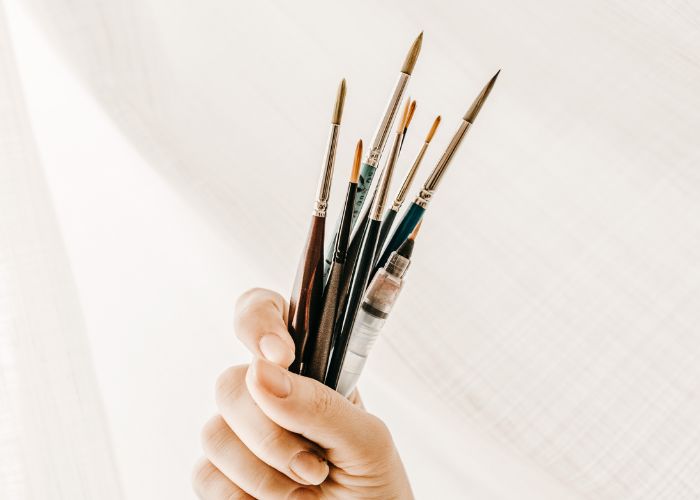Minimalist art, an aesthetic movement that flourished primarily in the 1960s and 1970s, is an artistic expression characterized by simplicity, clarity, and economy of elements.
In this post, we will explore the influence and impact of minimalist artists on the contemporary art scene. Through the reduction to the essential, minimalist artists seek to convey emotions and concepts in a direct and impactful manner, challenging conventional artistic norms and stimulating deeper reflection from the viewer.
In recent years, minimalist art has gained increasing importance and popularity in contemporary culture. Whether in painting, sculpture, architecture, or other forms of expression, the minimalist aesthetic continues to captivate artists and audiences worldwide.
Its influence can be seen not only in art galleries but also in fashion, interior design, and even in popular culture, reflecting a growing search for simplicity, clarity, and authenticity in an increasingly complex and stimulus-rich society.
Throughout this post, we will explore the main aspects and characteristics of minimalist artists, highlighting their most emblematic works and their legacy in the history of contemporary art.
What is Minimalist Art?
Minimalist art, also known as minimalism, is an artistic movement that emerged in the 1960s and 1970s, characterized by the extreme simplification of forms, colors, and materials. The primary objective of minimalism is to convey concepts and emotions through minimal and essential elements, avoiding any kind of excess or ornamentation.
In minimalism, less is more, and each element present in the work has a clear and defined purpose. Minimalist artists aim to create works that have a strong and impactful presence, even with few visual elements in play.
One of the main characteristics of minimalist art is the use of simple geometric shapes, such as straight lines, squares, circles, and triangles. These shapes are often organized symmetrically and orderly, creating a sense of harmony and balance in the composition.
Additionally, minimalism values the use of neutral and sober colors, such as white, black, gray, and beige, contributing to the serene and timeless feel of the works. Simplicity and resource economy are fundamental aspects of the minimalist aesthetic. Minimalist artists strive to eliminate any unnecessary or decorative element, focusing only on the essential to convey their message.
This results in works that often appear stripped-down and unassuming at first glance but reveal surprising depth and complexity when examined closely.
The economy of resources extends not only to the physical materials used in creating the works but also to how they are presented and exhibited, often favoring empty spaces and discreet lighting to further emphasize the simplicity and purity of the present elements.
The History of Minimalist Art: Origins and Evolution
The history of minimalist art dates back to the modern movement of the 20th century, characterized by a break with conventional artistic traditions and the search for a new visual language.
However, it was in the 1960s that minimalism emerged as a distinct and influential movement within the artistic scene. Originating mainly in the United States, minimalism was a reaction against the dominant abstract expressionism and pop art of the time.
Artists like Frank Stella, Donald Judd, and Agnes Martin were pioneers in this style, seeking to simplify form and reduce artistic expression to its most basic elements. Throughout its evolution, minimalist art was influenced by various movements and artistic currents, such as Russian constructivism, neoplasticism, and Dadaism.
However, minimalism also influenced other areas beyond the visual arts, such as architecture, design, and music. For example, architect Mies van der Rohe incorporated minimalist principles into his creations, such as the famous motto “less is more.”
Over time, minimalist art took on different forms and manifestations, adapting to social, cultural, and technological changes. While some artists remained faithful to the original principles of minimalism, others explored new techniques and materials, expanding the boundaries of the movement.
Moreover, the influence of minimalism can be seen in various forms of artistic expression, including sculpture, painting, installation, photography, and even performance.
This diversity of approaches and interpretations is one of the reasons why minimalist art remains relevant and inspiring to this day. Whether for its simple aesthetics, attention to form and space, or its ability to convey concepts and emotions directly and impactfully.
The Cultural Impact of Minimalist Artists
Minimalist art transcends the boundaries of the artistic world and exerts significant influence on contemporary culture. Its stripped-down aesthetics and unadorned form find relevance in various areas beyond the visual arts, including design, architecture, and fashion.
Minimalist artists, in their pursuit of essence and simplicity, often inspire professionals and enthusiasts in these fields to rethink their own practices and creative approaches.
In design, for example, the principles of minimalism are often applied in product and interface creation, aiming to eliminate unnecessary elements and prioritize functionality and usability. This results in more elegant and intuitive products that enhance the user experience.
Similarly, in architecture, minimalist architects strive to create spaces that are efficient, functional, and aesthetically pleasing, favoring clean lines, natural materials, and open spaces.
Beyond influencing design and architecture, minimalist artists also play an important role in reflecting on social and environmental issues. By questioning excessive consumption patterns and waste, they can stimulate a debate on sustainability and social responsibility.
Their works often encourage an appreciation for the beauty of simplicity and the value of the planet’s limited resources, inspiring a more conscious and balanced lifestyle.
Therefore, the cultural impact of minimalist artists goes beyond the art world, permeating various aspects of contemporary life. The philosophy of simplification and timeless aesthetics continue to influence society, challenging us to rethink priorities and value what truly matters.
Meet the Main Minimalist Artists
Here is a selection of some of the most prominent artists who have left their mark on the world of minimalist art, contributing to shaping and defining this unique and impactful aesthetic movement.
Donald Judd
Donald Judd was one of the main exponents of minimalism, recognized for his geometric sculptures and modular structures. His objective and rigorous approach to creating works, using industrial materials such as steel and acrylic, reflects minimalism’s commitment to simplicity and conceptual clarity.
Agnes Martin
Agnes Martin is known for her serene and contemplative paintings, characterized by subtle lines and geometric grids. Her work conveys a sense of tranquility and serenity, evoking a connection with the sublime and the transcendental through simplicity and the repetition of basic forms.
Sol LeWitt
Sol LeWitt is famous for his wall installations and conceptual drawings that explore ideas of seriality and repetition. His works are often created from simple and systematic instructions, allowing for various interpretations and executions while maintaining a minimalist aesthetic and an impactful visual presence.
Anne Truitt
Anne Truitt is recognized for her painted wood sculptures, characterized by geometric shapes and vibrant colors. Her minimalist approach combines formal precision with emotional sensitivity, creating works that are both rigorous and expressive.
These artists not only influenced the development of minimalist art but also left a lasting legacy that continues to inspire and encourage people today. Their works exemplify the fundamental principles of minimalism, demonstrating the beauty and power of simplicity in artistic expression.
Techniques and Approaches of Minimalist Artists
In the quest for maximum expression with minimal resources, minimalist artists employ a variety of techniques to create unique works that captivate through simplicity and conceptual depth. One of the main aspects of minimalist techniques is the emphasis on reduction to the essential. This is manifested in the careful selection of materials, the simplification of forms, and the use of neutral and sober colors.
Materials such as metal, glass, wood, and concrete are often preferred for their ability to convey a sense of solidity and permanence, while simple geometric shapes, such as straight lines and basic forms, are used to create clear and balanced compositions.
The choice of colors plays a fundamental role in the minimalist aesthetic, with artists often opting for a limited palette of neutral tones, such as white, black, gray, and earthy tones. This monochromatic approach contributes to the visual cohesion of the works and also allows the form and texture of the materials to stand out, creating a dramatic contrast and a sense of depth.
In addition to the choice of materials and colors, minimalist artists also explore simplicity as a means of conveying complex emotions and concepts. By removing unnecessary elements and reducing a work to its essence, they invite the viewer to contemplate the underlying meaning and engage more deeply with the piece. Minimalist art allows for various interpretations and personal experiences, making each encounter with the work a unique and introspective journey.
The techniques and approaches of minimalist artists reflect a commitment to clarity, simplicity, and depth. Their works not only challenge traditional artistic conventions but also invite us to rethink our relationship with space, time, and meaning in an era of so much information and complexity.
The Future of Minimalist Art
Considering the future of minimalist art, it is evident that this aesthetic movement will likely continue to play a significant role in the global art scene, maintaining its relevance and influence.
With society increasingly inundated with visual stimuli and information, the search for simplicity and essence in art becomes even more crucial. In this sense, minimalist art can offer a refreshing approach and a contemplative pause amid the frenzy of the modern world.
As we move forward, it is likely that minimalist artists will explore new directions and innovations within the minimalist style. This may include incorporating technologies such as virtual reality and artificial intelligence to create immersive and interactive experiences that challenge the perception of space and form.
Moreover, the intersection between minimalist art and social issues, such as sustainability and environmental justice, may become even more relevant as artists seek to address the challenges and dilemmas of the modern world.
However, regardless of the new directions that minimalist art may take, one thing is certain: minimalist artists will continue to challenge and inspire audiences in the future, as the ability to convey complex emotions and concepts through simple and essential elements is timeless.
In this context, minimalist art remains a significant force in contemporary culture, influencing not only the world of art but also design, architecture, and fashion. Its aesthetics of simplicity and clarity continue to resonate and captivate people around the world, offering a meaningful perspective on beauty and meaning in an increasingly complex and stimulus-rich world.
Conclusion
On this journey through minimalist art, we explore the nuances and fundamental aspects of this captivating aesthetic movement. From its origins in the 1960s to its evolution and impact on contemporary culture, it is clear that minimalist artists play a crucial role in the global art scene.
Through their refined works and simplified approaches, they challenge us to rethink our perceptions of form, space, and meaning, inviting us to contemplate the beauty in simplicity.
The importance of minimalist artists in the contemporary art scene is undeniable. Whether in painting, sculpture, architecture, interior design, or other forms of expression, their influence is widely recognized and celebrated.
Minimalist artists continue to inspire and captivate people with their ability to convey complex emotions and concepts through simple forms and modest materials.
Therefore, we invite you to explore more works by minimalist artists and reflect on the beauty of simplicity in art. May this journey through minimalist art inspire a deeper appreciation for the simple aesthetics of minimalism in art.
The theme of this post was inspired by The Collector.








